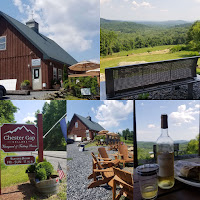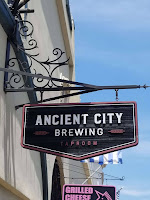 Over twenty years ago, John Delmare and his family planted the first vines on the historic Rappahannock County property they had purchased called Glenway Farm. This site in the Blue Ridge Mountains has been farmed since 1804 and is well suited for grapes with its high elevation (900' and 1200'); southeast aspect, with 10% grade; and rocky soil comprised of shale, limestone, and clay. They initially planted a variety of varieties from vinifera to hybrids - one such French hybrid being Vidal Blanc. This grape is a cross between the Vitis vinifera Ugni blanc and another hybrid variety, Rayon d'Or, and is intended to be winter-hardy with high sugar levels with moderate to high acidity.
Over twenty years ago, John Delmare and his family planted the first vines on the historic Rappahannock County property they had purchased called Glenway Farm. This site in the Blue Ridge Mountains has been farmed since 1804 and is well suited for grapes with its high elevation (900' and 1200'); southeast aspect, with 10% grade; and rocky soil comprised of shale, limestone, and clay. They initially planted a variety of varieties from vinifera to hybrids - one such French hybrid being Vidal Blanc. This grape is a cross between the Vitis vinifera Ugni blanc and another hybrid variety, Rayon d'Or, and is intended to be winter-hardy with high sugar levels with moderate to high acidity. Rappahannock Cellars released their first vintage of wines in 2000 and since that date, they have held back a portion of their Vidal Blanc in each successive year. They take that Vidal and siphon it into five-gallon glass casks and place on the winery's roof where it ages in the sun for 10 months. The direct sunlight and heat oxidize the wine which, when optimal, produces characters of cooked or dried fruit, nuttiness, and yeast. These casks are brought inside and aged over the winter and then back-blended with the previous vintages in their version of a Spanish Solara system. Each year the Solara gets older with a portion bottled for release - which they appropriately label Solera ($34).
Rappahannock Cellars released their first vintage of wines in 2000 and since that date, they have held back a portion of their Vidal Blanc in each successive year. They take that Vidal and siphon it into five-gallon glass casks and place on the winery's roof where it ages in the sun for 10 months. The direct sunlight and heat oxidize the wine which, when optimal, produces characters of cooked or dried fruit, nuttiness, and yeast. These casks are brought inside and aged over the winter and then back-blended with the previous vintages in their version of a Spanish Solara system. Each year the Solara gets older with a portion bottled for release - which they appropriately label Solera ($34).This wine is dry yet very complex - similar to a Spanish Oloroso sherry with nuttiness and yeastiness immediately apparent. Since the wine is naturally oxidized it can remain corked for a few months so is appropriate for sipping or in cocktails - one is mixing with grape brandy from the winery's sister distillery Dida's Distillery.
 The distillery honors the Delmare's great-grandfather Paul Mariani as Dida translates to Grandfather in Croatia and it was their Dida who immigrated to California and introduced the family to agriculture. Distiller Allan Delmare further commemorates their heritage by producing the Dida's Vintners Choice Immature Brandy ($40), a grape brandy in the tradition of the Croatian fruit brandies - rakija. In rare instances, you can find oak-aged rakija and in Hungary, the best home-made palinka's are those with a little oak seasoning. The Dida's has even more seasoning using 100% in new American charred oak barrels which smooth the rouge edges without overwhelming the fruit. I found my local rakija source. Zivjeli!!.
The distillery honors the Delmare's great-grandfather Paul Mariani as Dida translates to Grandfather in Croatia and it was their Dida who immigrated to California and introduced the family to agriculture. Distiller Allan Delmare further commemorates their heritage by producing the Dida's Vintners Choice Immature Brandy ($40), a grape brandy in the tradition of the Croatian fruit brandies - rakija. In rare instances, you can find oak-aged rakija and in Hungary, the best home-made palinka's are those with a little oak seasoning. The Dida's has even more seasoning using 100% in new American charred oak barrels which smooth the rouge edges without overwhelming the fruit. I found my local rakija source. Zivjeli!!.















































